Page 4 of 400
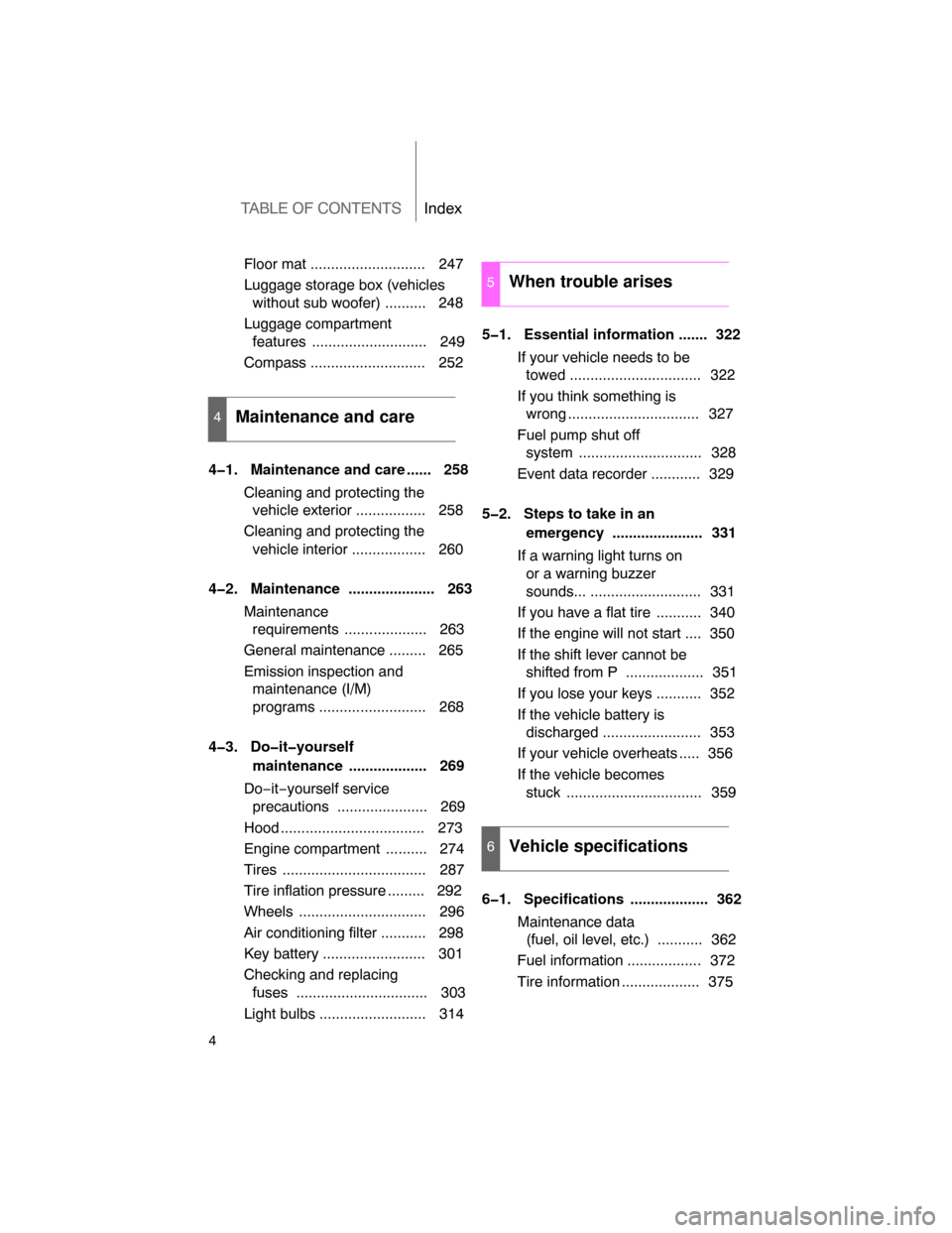
TABLE OF CONTENTSIndex
4
Floor mat ............................ 247
Luggage storage box (vehicles
without sub woofer) .......... 248
Luggage compartment
features ............................ 249
Compass ............................ 252
4�1. Maintenance and care ...... 258
Cleaning and protecting the
vehicle exterior ................. 258
Cleaning and protecting the
vehicle interior .................. 260
4�2. Maintenance ..................... 263
Maintenance
requirements .................... 263
General maintenance ......... 265
Emission inspection and
maintenance (I/M)
programs .......................... 268
4�3. Do�it�yourself
maintenance ................... 269
Do−it−yourself service
precautions ...................... 269
Hood ................................... 273
Engine compartment .......... 274
Tires ................................... 287
Tire inflation pressure ......... 292
Wheels ............................... 296
Air conditioning filter ........... 298
Key battery ......................... 301
Checking and replacing
fuses ................................ 303
Light bulbs .......................... 3145�1. Essential information ....... 322
If your vehicle needs to be
towed ................................ 322
If you think something is
wrong ................................ 327
Fuel pump shut off
system .............................. 328
Event data recorder ............ 329
5�2. Steps to take in an
emergency ...................... 331
If a warning light turns on
or a warning buzzer
sounds... ........................... 331
If you have a flat tire ........... 340
If the engine will not start .... 350
If the shift lever cannot be
shifted from P ................... 351
If you lose your keys ........... 352
If the vehicle battery is
discharged ........................ 353
If your vehicle overheats ..... 356
If the vehicle becomes
stuck ................................. 359
6�1. Specifications ................... 362
Maintenance data
(fuel, oil level, etc.) ........... 362
Fuel information .................. 372
Tire information ................... 375
4Maintenance and care
5When trouble arises
6Vehicle specifications
Page 111 of 400
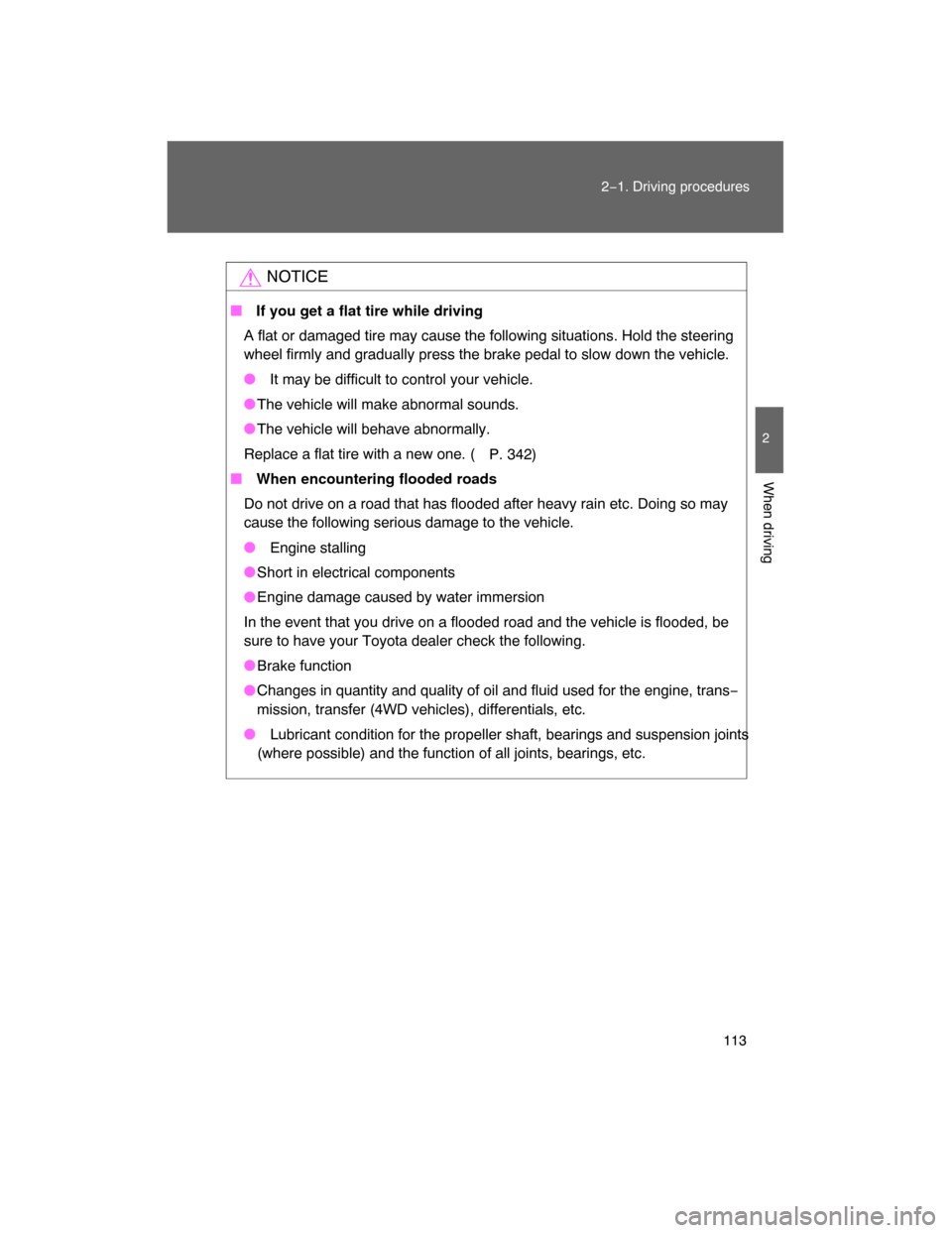
113
2−1. Driving procedures
2
When driving
NOTICE
� If you get a flat tire while driving
A flat or damaged tire may cause the following situations. Hold the steering
wheel firmly and gradually press the brake pedal to slow down the vehicle.
� It may be difficult to control your vehicle.
�The vehicle will make abnormal sounds.
�The vehicle will behave abnormally.
Replace a flat tire with a new one. (
P. 342)
� When encountering flooded roads
Do not drive on a road that has flooded after heavy rain etc. Doing so may
cause the following serious damage to the vehicle.
� Engine stalling
�Short in electrical components
�Engine damage caused by water immersion
In the event that you drive on a flooded road and the vehicle is flooded, be
sure to have your Toyota dealer check the following.
�Brake function
�Changes in quantity and quality of oil and fluid used for the engine, trans−
mission, transfer (4WD vehicles), differentials, etc.
� Lubricant condition for the propeller shaft, bearings and suspension joints
(where possible) and the function of all joints, bearings, etc.
Page 162 of 400
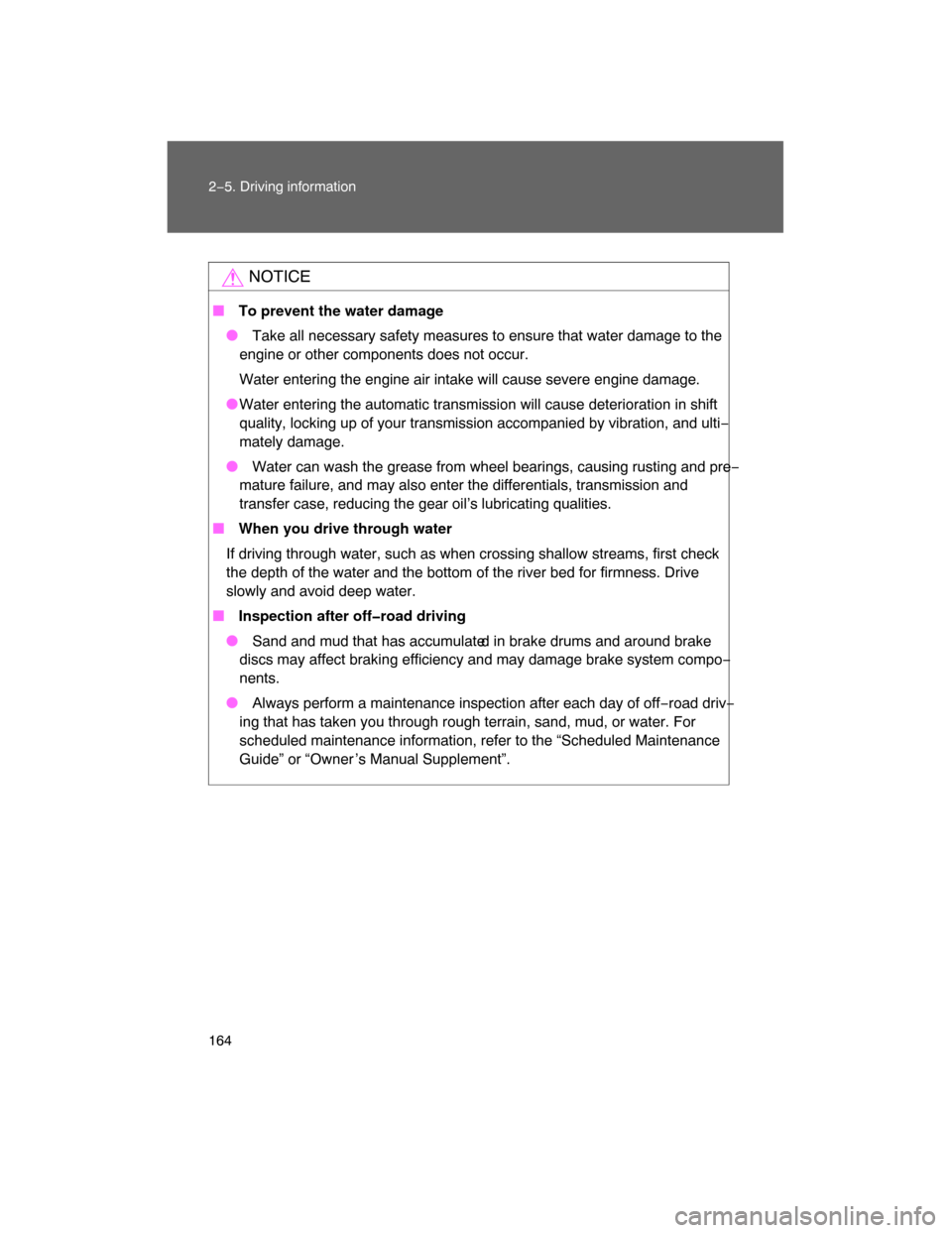
164 2−5. Driving information
NOTICE
� To prevent the water damage
� Take all necessary safety measures to ensure that water damage to the
engine or other components does not occur.
Water entering the engine air intake will cause severe engine damage.
�Water entering the automatic transmission will cause deterioration in shift
quality, locking up of your transmission accompanied by vibration, and ulti−
mately damage.
� Water can wash the grease from wheel bearings, causing rusting and pre−
mature failure, and may also enter the differentials, transmission and
transfer case, reducing the gear oil’s lubricating qualities.
� When you drive through water
If driving through water, such as when crossing shallow streams, first check
the depth of the water and the bottom of the river bed for firmness. Drive
slowly and avoid deep water.
� Inspection after off�road driving
� Sand and mud that has accumulate
d in brake drums and around brake
discs may affect braking efficiency and may damage brake system compo−
nents.
� Always perform a maintenance inspection after each day of off−road driv−
ing that has taken you through rough terrain, sand, mud, or water. For
scheduled maintenance information, refer to the “Scheduled Maintenance
Guide” or “Owner ’s Manual Supplement”.
Page 167 of 400

169
2−5. Driving information
2
When driving
Winter driving tips
Carry out the necessary preparations and inspections before driving
the vehicle in winter. Always drive the vehicle in a manner appropri�
ate to the prevailing weather conditions.
� Pre�winter preparations
� Use fluids that are appropriate to the prevailing outside tem−
peratures.
�Engine oil
�Engine coolant
�Washer fluid
� Have a service technician inspect the level and specific grav−
ity of battery electrolyte.
�Have the vehicle fitted with four snow tires or purchase a set
of tire chains for the rear tires.
Ensure that all tires are the same size and brand, and that chains
match the size of the tires.
� Before driving the vehicle
Perform the following according to the driving conditions.
�
Do not try to forcibly open a window, scrape an outside rear
view mirror surface or move a wiper or outside rear view mir−
ror that is frozen. Pour warm water over the frozen area to
melt the ice. Wipe away the water immediately to prevent it
from freezing.
�To ensure proper operation of th e climate control system fan,
remove any snow that has accumulated on the air inlet vents
in front of the windshield.
�Remove any ice that has accumulated on the vehicle chassis.
�
Periodically check for and remo ve any excess ice or snow
that may have accumulated in the wheel well or on the
brakes.
Page 204 of 400
207
3−2. Using the audio system
3
Interior features
NOTICE
� CD player precautions
Failure to follow the precautions below may result in serious damage to the
CDs or the player itself.
� Do not insert anything other than CDs into the CD slot.
�Do not apply oil to the CD player.
�Store CDs away from direct sunlight.
�
Never try to disassemble any part of the CD player.
� Do not insert more than one CD at a
time
Page 255 of 400
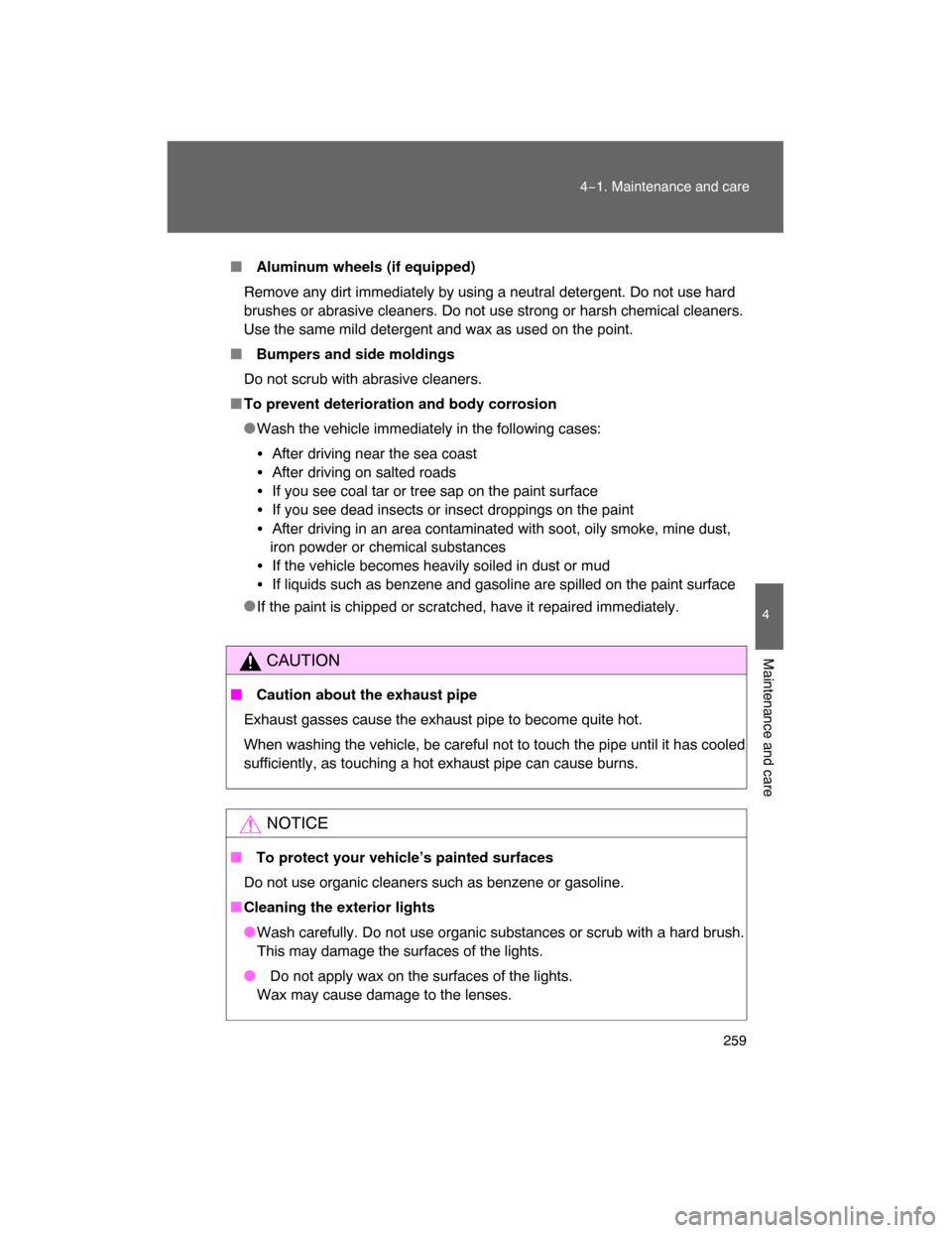
259
4−1. Maintenance and care
4
Maintenance and care
� Aluminum wheels (if equipped)
Remove any dirt immediately by using a neutral detergent. Do not use hard
brushes or abrasive cleaners. Do not use strong or harsh chemical cleaners.
Use the same mild detergent and wax as used on the point.
� Bumpers and side moldings
Do not scrub with abrasive cleaners.
�To prevent deterioration and body corrosion
�Wash the vehicle immediately in the following cases:
�After driving near the sea coast
�After driving on salted roads
�If you see coal tar or tree sap on the paint surface
�If you see dead insects or insect droppings on the paint
�After driving in an area contaminated with soot, oily smoke, mine dust,
iron powder or chemical substances
�If the vehicle becomes heavily soiled in dust or mud
�If liquids such as benzene and gasoline are spilled on the paint surface
�
If the paint is chipped or scratched, have it repaired immediately.
CAUTION
� Caution about the exhaust pipe
Exhaust gasses cause the exhaust pipe to become quite hot.
When washing the vehicle, be careful not to touch the pipe until it has cooled
sufficiently, as touching a hot exhaust pipe can cause burns.
NOTICE
� To protect your vehicle’s painted surfaces
Do not use organic cleaners such as benzene or gasoline.
�Cleaning the exterior lights
�Wash carefully. Do not use organic substances or scrub with a hard brush.
This may damage the surfaces of the lights.
� Do not apply wax on the surfaces of the lights.
Wax may cause damage to the lenses.
Page 260 of 400
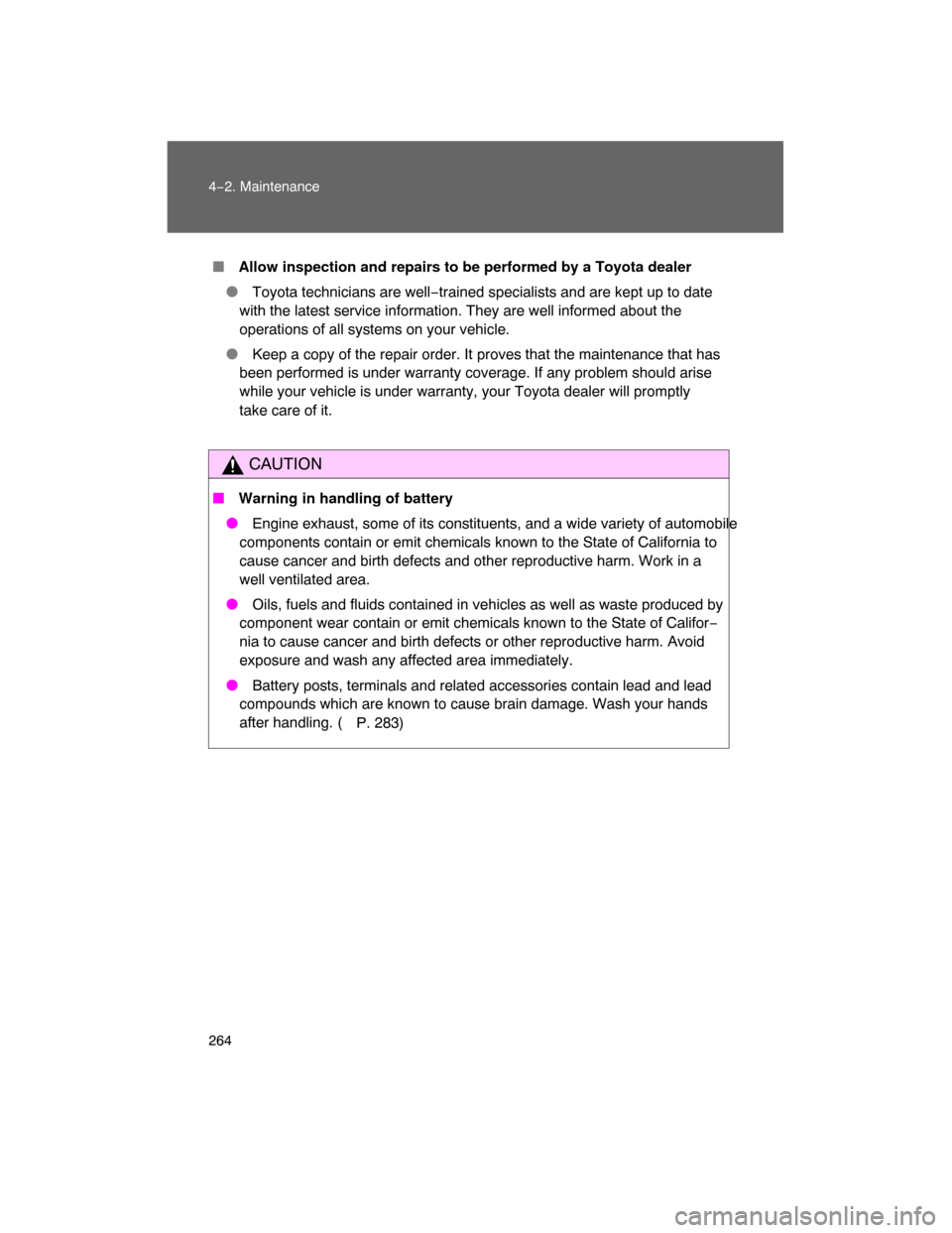
264 4−2. Maintenance
� Allow inspection and repairs to be performed by a Toyota dealer
� Toyota technicians are well−trained specialists and are kept up to date
with the latest service information. They are well informed about the
operations of all systems on your vehicle.
� Keep a copy of the repair order. It proves that the maintenance that has
been performed is under warranty coverage. If any problem should arise
while your vehicle is under warranty, your Toyota dealer will promptly
take care of it.
CAUTION
� Warning in handling of battery
� Engine exhaust, some of its constituents, and a wide variety of automobile
components contain or emit chemicals known to the State of California to
cause cancer and birth defects and other reproductive harm. Work in a
well ventilated area.
� Oils, fuels and fluids contained in vehicles as well as waste produced by
component wear contain or emit chemicals known to the State of Califor−
nia to cause cancer and birth defects or other reproductive harm. Avoid
exposure and wash any affected area immediately.
� Battery posts, terminals and related accessories contain lead and lead
compounds which are known to cause brain damage. Wash your hands
after handling. (
P. 283)
Page 261 of 400
265
4−2. Maintenance
4
Maintenance and care
General maintenance
Engine compartment
Items Check points
Battery Maintenance−free. ( P. 283)
Brake fluid At the correct level? ( P. 280)
Engine coolant At the correct level? ( P. 279)
Engine oil At the correct level? ( P. 275)
Exhaust system No fumes or strange sounds?
Power steering fluid At the correct level? (
P. 282)
Radiator/condenser/hosesNot blocked with foreign matter?
(
P. 280)
Washer fluid At the correct level? (
P. 286)
Listed below are the general maintenance items that should be per�
formed at the intervals specified
in the “Scheduled Maintenance
Guide” or “Owner ’s Manual Supp lement”. It is recommended that
any problem you notice should be brought to the attention of your
Toyota dealer or qualifie
d service shop for advice.